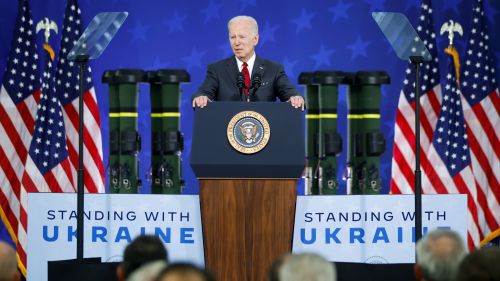What Has the United States Sent to Ukraine so Far?

Roughly $24 billion in military aid has been authorized for Ukraine since August—dwarfing total US assistance to the country in all previous years.
From August 2021 to the present, President Joe Biden has used presidential drawdown authority under Section 506(a)(1) of the 1961 Foreign Assistance Act and congressional authority to authorize the transfer of roughly $23.7 billion worth of US defense equipment and weapons to Ukraine. (This $23.7 billion figure includes congressional authorizations that are still funding drawdowns.) This has dwarfed total US security aid to Ukraine in all previous years, which has hovered between $150 and $450 million annually since Russia’s 2014 invasion of Crimea.
What the United States has provided has shifted over time, according to detailed lists of defense items sent to Ukraine which the Department of Defense began releasing in March. From December to February, roughly $550 million worth of Javelin anti-tank guided missiles, other anti-armor systems, body armor, munitions, and helicopters were transferred to Ukraine. This probably reflected Washington’s realization that Russia’s troop buildup was a prelude to a land invasion, against which Javelin anti-tank weapons would be useful.
As of June, Washington was delivering vehicles and weapons more suited to combined-arms warfare—namely artillery, infantry weapons, anti-armor weapons, and armored infantry vehicles. Notably, after refusing in May to send short-range missiles for fear of Kyiv using them to strike into Russia, Biden agreed to send four mobile short-range missile systems to Ukraine on June 1. Shortly after, the United Kingdom announced it would follow.
| Type of System | Systems |
|---|---|
| Anti-air/anti-armor | - Stinger anti-aircraft systems (> 1,400) - Javelin anti-armor systems (>6,500) - Other anti-armor systems (>20,000) - Switchblade Tactical Unmanned Aerial Systems (>700) |
| Artillery | - 155mm Howitzers (126) - 155mm artillery rounds (>256,000) - Tactical Vehicles to tow 155mm Howitzers (108) - High Mobility Artillery Rocket Systems (not yet delivered) |
| Infantry equipment | - Small arms (>7,000) - Small arms ammunition (>50 million rounds) - Body armor and helmets (75,000 sets) - Explosive ordnance disposal protective gear - M18A1 Claymore anti-personnel munitions - C-4 explosives and demolition equipment for obstacle clearing - Tactical secure communications and jamming systems - Night vision devices, thermal imagery systems, optics, and laser rangefinders - Medical supplies |
| Vehicles | - Mi-17 helicopters (20) - Armored High Mobility Multipurpose Wheeled Vehicles - M113 Armored Personnel Carriers (200) - Harpoon coastal defense systems, vehicle-mounted (2) |
| Radars | - Counter-artillery radars (22) - Counter-mortar radars (4) - Air surveillance radars (2) |
| Unmanned Systems | - Phoenix Ghost Tactical Unmanned Aerial Systems (121) - Puma Unmanned Aerial Systems - Unmanned Coastal Defense Vessels |
US arms transfers in March reflected concerns that Kyiv was in danger of falling to the initial Russian offensive. These transfers included ammunition, small arms, and tactical gear; radar systems for countering Russian artillery mortars; drones; more Javelins; and Stinger anti-aircraft missiles. Anti-air and anti-armor systems were particularly prominent in US policy discussions for their contributions against Russian air and armored units, which had numerical superiority over their Ukrainian counterparts. Vehicles, radars, and supplies that further enabled Ukrainian forces to defend against Russian attacks were seen as helpful for keeping Ukraine in the fight.
Security assistance in April and May 2022 grew to include more aerial drones, including armed systems, and artillery capabilities (guns and shells). Aerial drones have been widely publicized for their success in attacking Russian tanks. Moreover, the shift of momentum in April as Russia was forced to pull back its offensive drive in northern Ukraine led to a greater emphasis on artillery and armed drones in Kyiv’s weapons requests. Washington has also provided the Ukrainian Armed Forces with spare parts, equipment, satellite imagery, and other intelligence since February 2022.
Official US statements on the delivery of artillery systems to Ukraine reflect the rapid process of training and equipping Ukrainian soldiers that would ordinarily be done at a slower pace through peacetime programs, such as the International Military Education and Training program or the US military’s Joint Multinational Training Group-Ukraine. A Pentagon press release in late April claimed that over 50 M-777 howitzers from the United States had been transferred to Ukraine while US soldiers were simultaneously training Ukrainian soldiers in Germany. Two weeks later, Ukraine’s minister of defense claimed that Ukraine had deployed 74 howitzers.
According to the Pentagon’s fact sheets, Washington sent around 1,000 Javelin missiles, 7,000 other anti-armor systems, 20,000 artillery rounds, four helicopters, and two counter-artillery radars in May. Eighteen M-777 howitzers, 36,000 more artillery rounds, short-range missiles, and two coastal defense missile systems have been authorized in June.
The timing and type of assistance the United States has provided to Ukraine’s armed forces reflect not only shifts on the battlefield but also an ongoing debate in Washington over the US interests at stake and escalation risks posed by different kinds of equipment. While opponents of US security assistance in Washington are still far outnumbered by supporters of aid, the trajectory of the war is still uncertain, making predictions about future US assistance difficult.

